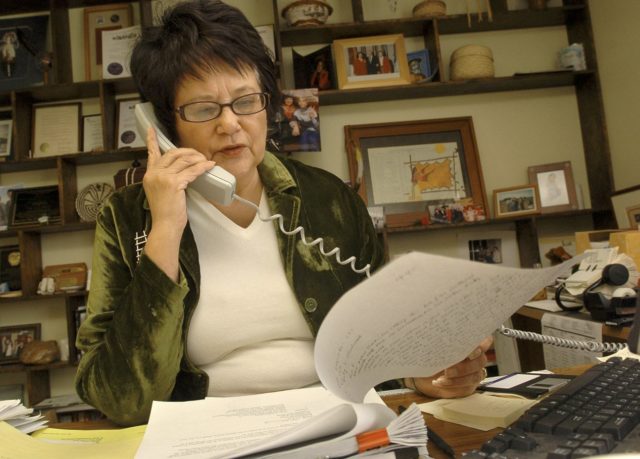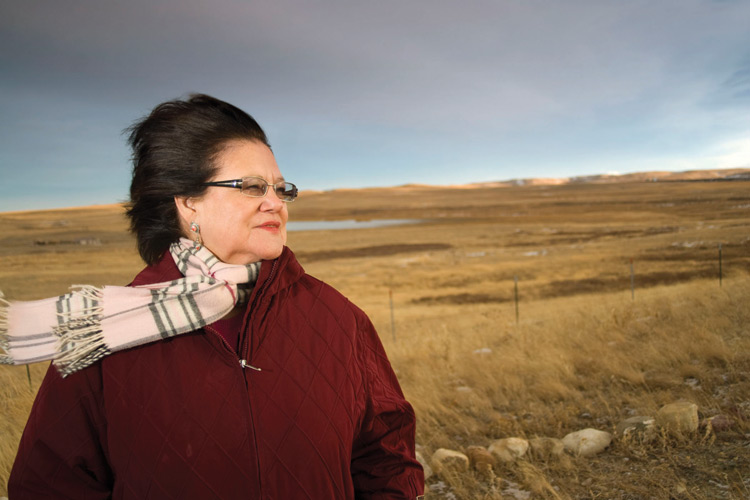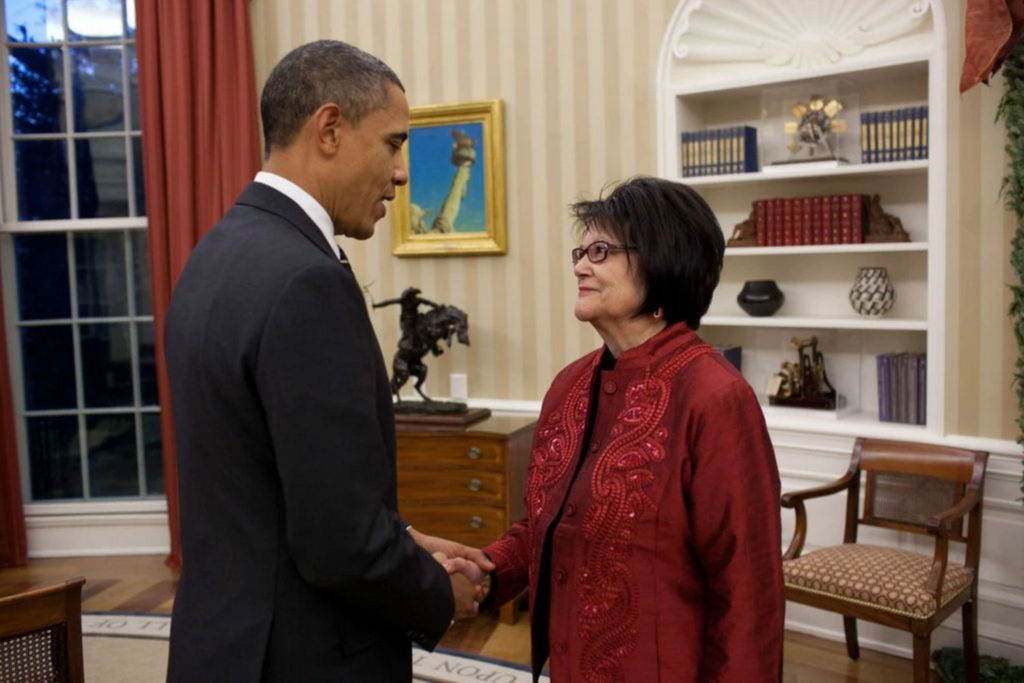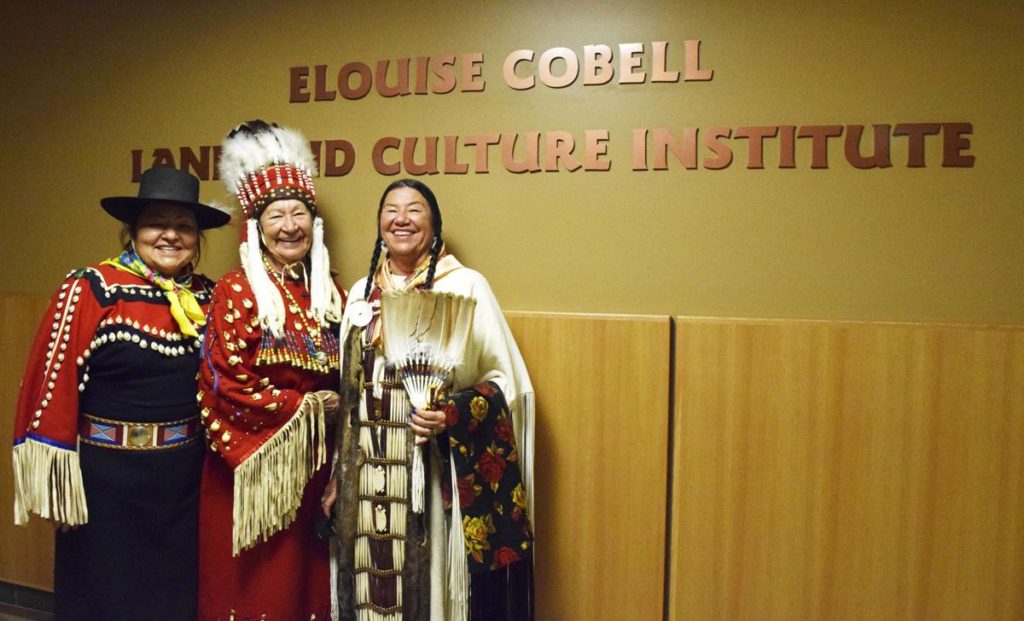 -
-GFT, 23.11.2005:1A -- Elouise Cobell works in her office at the Blackfeet Reservation Development Fund, Inc. in Browning, Mont., Tuesday, Nov. 15, 2005. Cobell, a Blackfeet Indian, is the lead plaintiff in Cobell vs. Norton, the longest and largest class-action lawsuit brought against the government. (GNS Photo/Robin Loznak)
-
-GFT, 23.11.2005:1A -- Elouise Cobell works in her office at the Blackfeet Reservation Development Fund, Inc. in Browning, Mont., Tuesday, Nov. 15, 2005. Cobell, a Blackfeet Indian, is the lead plaintiff in Cobell vs. Norton, the longest and largest class-action lawsuit brought against the government. (GNS Photo/Robin Loznak)
By Sherry Wack*
Most people know about the Trail of Tears, the forced removal of Native Americans from their traditional homes in the Eastern U.S. Actually, there were many Trails of Tears, but the most infamous one happened like this:
President Thomas Jefferson had promised the “Five Civilized Tribes” of the Southeastern U.S.–Cherokee, Chickasaw, Choctaw, Creek (Muscogee), and Seminole peoples—that if they adopted the white man’s ways, “We would all live as brothers.” And they did. The Cherokee Nation even developed a system of writing for their language and created a constitution modeled after the U.S.
But soon, encroaching white immigrants wanted their land. The Cherokee fought all the way to the U.S. Supreme Court and won the rights to keep their sovereignty and their land.
However, President Andrew Jackson defied the court. In the summer of 1838, he allowed the Georgia militia and others to forcibly round up all the Indians in the Southeast and place them in stockades. There most elderly prisoners and infants died from heat exposure and squalid conditions; and women were routinely raped.
Then the Indians were forced to walk from Mississippi to Oklahoma, by way of St. Louis, Mo., in the dead of the worst winter in decades. Over 5,000 died. Survivors finally reached Oklahoma, then called Indian Territory, where the government promised they could stay “as long as the grass grows and the sun shines.”
Fast forward 49 years and guess what? More non-Native immigrants kept pouring into the land, occupying more and more of the Indian Territory. They needed more room. So, the U.S. government passed the Dawes Act of 1887.
“Instead of having all this land in community,” they told the Indians, “we’re going to give each individual a parcel of land; and if there is any left over, we will sell it and put the money in trust.” So, then we had the Oklahoma Land Rush. The Indians’ land was reduced from 150 million acres down to 55 million.
What were the Indians to do with their parcels of land? “They should become farmers,” President Teddy Roosevelt said. Well, many knew nothing about farming. They were used to hunting and foraging; but now they weren’t allowed to carry firearms, and now the land was much more crowded.
So, the only option left to them was to lease their land to private investors for oil and gas extraction, timber removal, grazing and farming. The government said, “Indians are too stupid to handle their own money, so we will keep the money for them.”
So, all the lease payments went into the Indian Trust Fund. If an Indian wanted to buy a cow or food for their family, they had to see the Bureau of Indian Affairs agent and beg for it. Sometimes they got it. and sometimes they didn’t. In Montana the agent sold all of the government rations earmarked for the tribe and over 600 died of starvation.
Meanwhile the Indian Trust Fund kept growing. In 1915 Congress recognized fraud in the fund, “almost beyond the ability of comprehension.” But Congress did nothing about it.

Elouise Cobell (Yellow Bird Woman) was born on the Blackfeet Reservation in Montana. She went to college and became a banker. She liked working with figures and knew how to manage money. When she became treasurer of the Blackfeet tribe, she began investigating payments to local Indians from the Indian Trust Fund. One man had a report from the oil well on his property that showed the oil company received $6,000 from sale of the oil, but he got a check for only $89.
As Elouise investigated further, she discovered that $2.4 billion was missing from the Indian Trust Fund. On June 10, 1996, Elouise Pepion Cobell and the Native American Rights Fund filed suit against the U.S. Department of the Interior and Department of the Treasury on behalf of 300,000 individual Indians for gross mismanagement of the Indian Trust Fund. As the suit proceeded, records were difficult, sometimes impossible to find. Reams of paper files were stashed in sheds and warehouses.
The litigation went on for 14 difficult years. The government had 200 lawyers on the case, Elouise had only three. The court found in favor of the Indians; but President George W. Bush pulled the case and shelved it for the next administration to handle.
Finally, President Barack Obama and Congress approved the court’s decision in 2011; and the plaintiffs were awarded $3.4 million in the largest successful class action suit ever brought against the U. S. government.

Elouise Cobell died from cancer four months later, just before the first Cobell Settlement checks were mailed. The Department of the Interior flew flags at half-staff in her honor. Today the monies are still being disbursed as the different tribes come forward to claim their awards.
Congressman Tom Cole (R-OK) said, “In 50 years we’re going to talk about Elouise Cobell like we talk about Rosa Parks. She’s a great American who stood up for the rights of her people and in doing that, that expands the rights for all Americans.”
You can see her story in a documentary entitled 100 Years: One Woman’s Fight for Justice now streaming on Netflix. Watch the dramatic trailer on YouTube.

*Sherry Wack is co-chair of the Eastern PA Conference Committee on Native American Ministry (CONAM)
